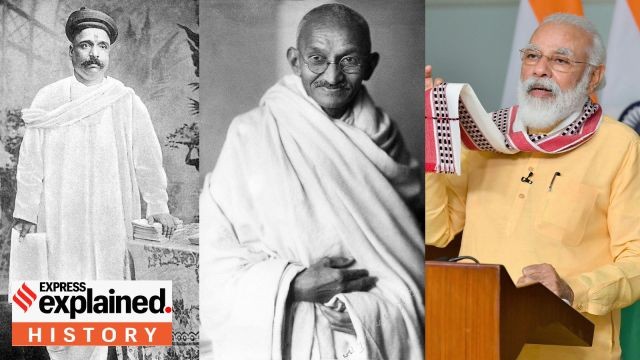



The Swadeshi Movement, rooted in India’s fight against colonial economic exploitation, emphasized using indigenous goods and rejecting foreign products. While it played a crucial role in uniting people during the freedom struggle, its post-independence influence led to protectionist economic policies. In modern times, Swadeshi has re-emerged through initiatives like Make in India and Aatmanirbhar Bharat

Copyright infringement not intended
Picture Courtesy: The Indian Express
Recently, the Indian government has revived swadeshi ideas. Union ministers have started using Indian software like Zoho Mail, and the Ministry of Education has directed officials to use indigenous platforms to boost digital sovereignty.
|
Period |
Phase/Development |
Key Features & Events |
Notable Figures |
|
Mid-19th Century |
Origins – Economic and Cultural Critique |
Critique of British colonialism; argued it deindustrialised India and drained wealth. |
Dadabhai Naoroji, Romesh Chunder Dutt |
|
Late 19th Century |
Swadeshi as a Moral Responsibility |
Buying local seen as a moral and patriotic act; Gandhi viewed it as essential for ethical living and self-reliance. |
Mahatma Gandhi, Mahadev Govind Ranade |
|
1905 |
Political Weapon in Freedom Struggle |
Swadeshi Movement post-Partition of Bengal: Boycott of foreign goods, public protests, strikes, promotion of indigenous industries. |
Bal Gangadhar Tilak, Lala Lajpat Rai |
|
1930s–1947 |
Economic Ideology for National Development |
Advocacy for Indian-owned industry; Swadeshi became a framework for future economic planning and socialism-inspired industrial development. |
Indian National Congress leaders |
|
1950s–1980s |
Post-Independence: Protectionism & Mixed Economy |
Emphasis on import substitution, state-led growth, heavy industry; swadeshi became a tool for protecting domestic industry—but led to inefficiencies and stagnation. |
Jawaharlal Nehru, Planning Commission |
|
1991 |
Liberalisation and Decline of Swadeshi Policy |
Economic reforms opened markets; globalisation replaced swadeshi as economic logic. |
Manmohan Singh, P. V. Narasimha Rao |
|
2008–2019 |
Global Crisis and Return of Economic Nationalism |
Rise in global protectionism post-2008 crisis; early revival of swadeshi sentiments globally and in India. |
RSS, Swadeshi Jagran Manch |
|
2019–Present |
Swadeshi 2.0: Digital & Strategic Self-Reliance |
Make in India, Aatmanirbhar Bharat, digital swadeshi (Zoho Mail, Koo); push driven by China tensions, COVID-19, and global supply chain realignments. |
Narendra Modi, Amit Shah, Sridhar Vembu |
Government initiatives in supporting Swadeshi:
|
Initiative |
Year Launched |
Objective |
Key Highlights |
|
Make in India |
2014 |
Boost manufacturing, attract FDI |
Targeted 25 sectors; FDI rose from $45B (2014) to $85B+ (2022–23) |
|
Aatmanirbhar Bharat Abhiyan |
2020 |
Promote self-reliance post COVID-19 |
₹20 lakh crore stimulus; reforms in MSMEs, agriculture, healthcare |
|
PLI Scheme |
2020 |
Incentivize domestic manufacturing in key sectors |
₹1.97 lakh crore allocated; sectors include electronics, pharma, semiconductors |
|
Digital India |
2015 |
Empower through digital infrastructure using local tech |
Adoption of BHIM, Digilocker, Zoho Mail; push for data localization |
|
Startup India |
2016 |
Foster innovation, promote entrepreneurship |
Over 1.25 lakh startups recognized; tax & regulatory benefits |
|
Vocal for Local |
2020 |
Encourage public preference for indigenous products |
Campaign linked to Aatmanirbhar Bharat; "Make it global" push |
|
Government e-Marketplace (GeM) |
2016 |
Transparent procurement of goods/services by govt |
50%+ local content preferred; ₹4 lakh crore procurement milestone |
|
One District One Product (ODOP) |
2018 |
Promote local crafts and unique regional products |
Skill development, branding & marketing support for local businesses |
|
Public Sector Procurement Norms |
Ongoing |
Encourage local sourcing in defence & govt sectors |
68% of defence capital budget (2023–24) for Indian industry |
|
Swadeshi Jagran Manch Advocacy |
Since 1990s |
Policy pressure for economic nationalism |
Influence in e-commerce, FDI, and domestic industry protection |
Source: The Indian Express
|
Practice Question Q. Critically examine the relevance of the Swadeshi model in India’s current economic landscape, especially in the context of globalisation and self-reliance. (250 words) |
The Swadeshi Movement was a nationalist movement in India that advocated the use of indigenous goods and boycotting British products. It began prominently in 1905 during the Partition of Bengal.
Prominent leaders included Bal Gangadhar Tilak, Bipin Chandra Pal, Lala Lajpat Rai, and Mahatma Gandhi, who later shaped its moral and economic dimensions.
While Swadeshi emphasizes using domestically made products, Aatmanirbhar Bharat focuses on building self-reliance through local production, innovation, and integration with global value chains.


© 2025 iasgyan. All right reserved